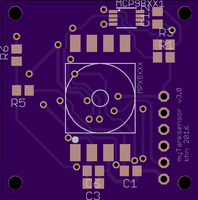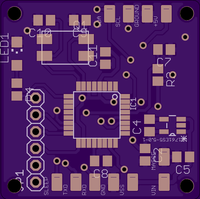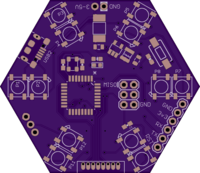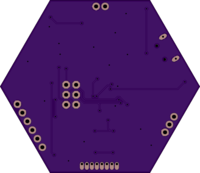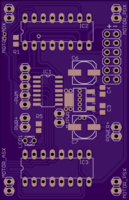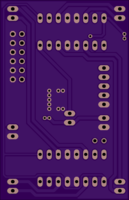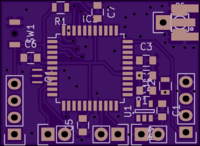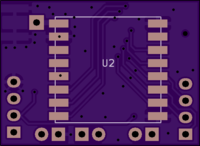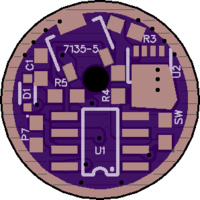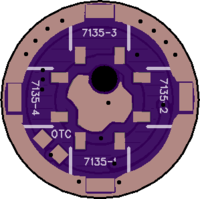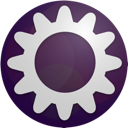
OSH Park
Shared projects
- You need to sign in or sign up before continuing.
tankstand_v3
by
2
layer board of
1.18x1.18
inches
(30.02x30.02
mm).
Shared on
September 26th, 2016 20:58.
tankstand_v3
Archive.zip
by
2
layer board of
2.00x1.73
inches
(50.80x44.02
mm).
Shared on
September 26th, 2016 20:24.
Ar4wDriver.brd
by
2
layer board of
1.41x2.20
inches
(35.86x55.88
mm).
Shared on
September 26th, 2016 20:04.
4 DC motors arduino board This board allows to individually control speed and direction of four dc motors. The control is in Iocked antiphase mode (LAP) and uses only four Arduino pins. The on board 5vcc voltage regulator also allows to supply other external devices, without overloading the Arduino regulator.
AtmegaRFM.kicad_pcb
by
2
layer board of
1.19x0.87
inches
(30.30x22.12
mm).
Shared on
September 26th, 2016 14:37.
15mm Texas Avenger Driver Normal version
by
2
layer board of
0.60x0.60
inches
(15.16x15.16
mm).
Shared on
September 26th, 2016 13:47.
TA15 – 15mm version : Here is a super tiny version of the Texas Avenger driver series. Due to the size it uses slightly different components then the larger ones. It is missing C2, R1 & R2 (It must use a firmware with internal LVP reference enabled) and the bleeder resistor.
The FET has also been changed to an LFPAK33 instead of the 56. It also has 2 sets of OTC pads, this is because using the top side pads will prevent you from programming the MCU on board. The EX pads go to Pin 7 and are there for future expansion. Otherwise it is the same as the rest.
There are 2 versions of this driver. The compact version has the components placed super compact to allow as much edge clearance as possible. You can sand it down to under 14mm. The downside to this is that it will not be able to be programmed without removing something from the driver.
The normal version should allow even a Tiny85 (with pins bent to fit naturally) to be programmed on board but has much less edge clearance.
Info thread for this driver is here: http://budgetlightforum.com/node/48447
Ok, the idea with these drivers is that I can order them from OSHpark and keep them on hand for any build I may desire.
The real key feature is the 3 channels combined with bistro and Narsil firmware to give you nearly endless options when it comes to UI.
I find that the single 7135 is a great regulated low mode, even for high powered triples. Also a must for truly low moon modes.
The FET is obviously for turbo and works great at getting the most lumens possible.
The bank of 6-8 7135’s is where things change from your normal FET+1 setup. This bank allows for a great non-PWM, regulated high mode on most lights and you can simply leave some 7135’s off to adjust it to your exact liking. Or if you need the space leave them all off and you can then clear any retaining ring you may desire.
Here is a feature list
- The latest FET + 7135 circuit that DEL scoped out and improved
- Full copper pour over the board to improve heatsinking of all the components
- 3 fully PWM channels, 1 to a LFPAK56 FET, 1 to a single 7135 on the top of the board and the last goes to a bank of 7135’s on the bottom of the board.
- Lots of edge clearance on the large drivers
- Large LED+ wire pass through, suitable for 20-18 gauge silicone wire, even larger if teflon coated wire.
- Bleeder resistor for lighted tailcaps
- Zener pads for higher voltage applications
- Attiny85 ready for all but the 15-19mm versions.
- Toykeepers amazing Bistro firmware : http://bazaar.launchpad.net/~toykeeper/flashlight-firmware/tiny25/files/head:/ToyKeeper/bistro/
- Thermal management with the bistro firmware!
So now to the Drivers themselves, they are designed around the parts list from DEL.
R1 : 22 k (or 220 k for e-switch lights, like you have been using) R2 : 4.7 k (or 47 k for e-switch lights) R3 : 100 k R4 : 47 ohm R5 : 4.7 ohm BR : Bleeder resistor for lighted tailcaps, varies between 470-630ohm (optional)
C1 : 10 uF C2 : 0.1 uF OTC : 1 uF
U1 : SOIC-8 footprint Attiny25 for bistro, the 20mm+ versions have pads for the Attiny85, the 25 & 45 also fit on them U2 : LFPAK56 MOSFET (aka, “FET”). PSMN3R0-30YLDX is a popular cheap option, the SIR800DP is better but costs more.
D1 : Schottky Diode SOD-323 Z: “Zener diode”:https://www.digikey.com/product-detail/en/diodes-incorporated/MMSZ5229BS-7-F/MMSZ5229BS-FDICT-ND/815866 SOD-323 (Optional, only needed for 2S+ operation)
7135 : Standard 350ma or 380ma 7135’s can be installed on these pads. I prefer 350ma myself. You will need to clip the center pin of the top side 7135 if you plan to use a bleeder resistor. The 7135’s can be purchased from http://www.mtnelectronics.com/index.php?route=product/product&path=25_76&product_id=60 or https://www.fasttech.com/products/1124300
The resisters are all 0603 package (but you can use 0805 if you desire, just have to be more careful when building the driver).
Diode and Zener are both SOD-323 package.
The C1 cap is 0805 in all cases. C2 is 0603 in all cases (0805 could be used). The OTC is 0603 in the 17mm version and 0805 in the others, this is to make e-switch conversions easier.
You can fit 0805 on the 0603 pads if you are careful but if ordering new components, might as well go with 0603. The same can be done in reverse, you can put 0603 on the 0805 pads.
Here is a DigiKey shopping cart with the components I used, there are both better and also cheaper options available if you want to pick out your own, so this is just for reference I like getting a bit tighter tolerance OTC as it can help when things get hot for example).
The items with a quantity of 1 have multiple options that you will need to pick from in the cart. These are the FET’s and MCU. The SIR404 is the better FET but costs over twice the price, the NXP works just fine for most things. The other are the Attiny version that you want. As it stands right now you need the Attiny25 for Bistro and the Attiny85 for Narsil (aka, e-switch). You can also get the MCU/FET from RMM as well for a bit less money. http://www.mtnelectronics.com/index.php?route=product/category&path=25_104
http://www.digikey.com/short/3hzvd7
Also note that the cart includes both 0805 and 0603 OTC caps, you can remove one if you desire. The 7135’s are not included in this shopping cart as I don’t think digikey sells them, they are best ordered from links above.
The firmware that can be used with this driver is the Bistro Tripledown variation which can be found here: http://bazaar.launchpad.net/~toykeeper/flashlight-firmware/tiny25/files/head:/ToyKeeper/bistro/
https://s4.postimg.org/nyr04zj4t/bistro_ui.png
The downloads from OSHpark includes the source files for diptrace for anyone that wants to play around with it, along with pictures of the drivers assembled from diptrace to make assembly easier and a schematic for each one.
Here is the schematic that is used for all of them (save for the number of 7135’s of course).
http://i.imgur.com/0fDDPV4.jpg
